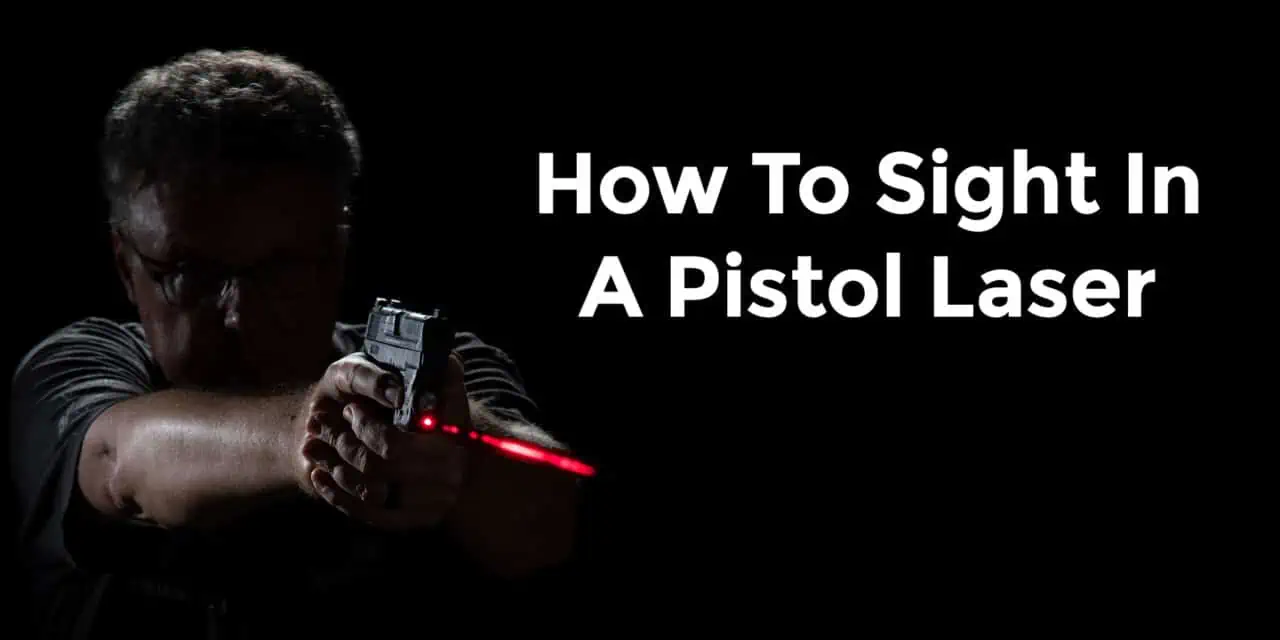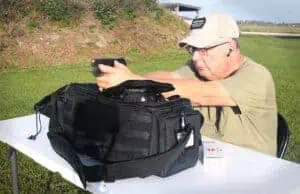How To Sight In A Laser on Pistol
It’s an iconic scene in American movie history. A ruthless robotic hunter in human form locates his prey in a crowded and dark Los Angeles nightclub. On top of his pistol is a huge red laser sight that reinforces the idea that he is more than human, and that the normal frailties of human eyesight far behind.
That unforgettable scene in “The Terminator” kicked off America’s interest in laser-sighted pistols. The laser used in that movie was cumbersome and impractical. However, lasers soon shrunk in size to where they can be mounted on just about any gun. Now they are a popular option to add to a defensive pistol. Just adding one to your gun is not enough, though, as you need to make sure the laser is pointing to where your bullets are hitting on your target. This means a trip to the range, and knowing how to sight in a laser on a pistol.
Why Use A Laser?
First, let’s talk about why you want a laser on your pistol (other than to make you feel like Arnold Schwarznegger, of course). The first is accuracy. A laser sight will (in theory) show you exactly where your rounds are going to land on your target, eliminating the need for both a sight picture and proper sight alignment. A laser sight will also allow you to make faster follow-up shots. If you can see the laser on your target, (and that is “if”… more on that later), you can track how your gun is moving under recoil and quickly get your point of aim back where it belongs.
In addition to these, one of the nicest things about a laser on your gun is that it allows you to get good hits from awkward shooting positions. You don’t need to have a perfect sight alignment and sight picture with a laser sight. This means your gun doesn’t need to be in front of your eyes to get good hits. You can even hide behind cover and bring your gun into play, relying on where the laser dot is landing on your target to get your hits.
Drawbacks Of A Laser Sight
There are some downsides to a laser, though. With a few exceptions from Viridian and Crimson Trace, they need to be switched-on in order to work, which can slow down your draw time. A laser sight also requires batteries which can run out of power at inopportune moments, and laser sights are not available for some kinds of pistols.
The biggest issue I’ve seen with laser sights, however, is the difference between how they operate in indoor light versus outdoor light. We buy guns indoors, and when we do, the dot from the laser shows up nicely wherever it is pointed. This is not true once you go to an outdoor range. I shoot on public outdoor ranges quite often, and I have seen the shock on so many gun owner’s faces when the bright red (or green) dot they saw indoors is nowhere to be seen outside. I’ve even seen people wave their hand in front of a loaded gun, trying to see the spot from their laser sight in the bright sunlight.
A Useful Tool, Or Just A Toy?
Despite this, I consider a laser sight to be a very good idea for guns with little or no sights, such as my Ruger LCPII. I use a Crimson Trace Green Laserguard on that gun, and getting that laser to match up with the bullet’s point of impact on the target means knowing how to sight in a laser on a pistol.
To begin with, you’re going to need a stable firing platform. A table works just fine, as does the shooting bench at your local range. You’ll probably want to sit down while doing this, so if your range doesn’t allow that, I’d recommend trying this at another range that does. You’ll need something to rest your gun on, such as a shooting bag, backpack or something else that can hold your pistol steady as you shoot. You’ll also need ammo, ideally the same defensive rounds you’ll be carrying in your gun everyday, as well as something to shoot at, and a marker pen of some kind. Finally, you’ll obviously need your gun, your laser sight and the instructions on how it works.
How To Sight In A Laser on Pistol At The Range
As I said before, a lot of people run into trouble when sighting in their new laser sights because they can’t see the aiming dot on the target. To overcome that, we’re going to make our target as plain and reflective as possible, and shoot at a big white sheet of paper. The lack of markings or different colors on the target will make our job a lot easier. We’ll make a big “X” in the center of the target to give us an aiming point, but other than that, we’ll make no marks except bullet holes in the paper.
Target distance is important here, because that’s the distance where your bullet impacts and the laser dot are going to line up. Your rounds will land more and more below the dot as the target gets closer than your sight-in distance. Conversely, shots on targets further away than your sight-in distance will land further and further above the dot as the distance increases. I prefer to sight in the laser on my defensive pistol at 10 yards, which should suffice in any defensive encounter that I might unfortunately find myself facing.
The Sighting-In Process
The process of sighting in a laser is actually quite easy, it just takes a while.
- Load your gun with one round and activate your laser.
- Place the aiming dot of the laser on the “X” you made on the target.
- Shoot a round.
- Make your gun safe, and adjust the windage and elevation settings on your sight so the point of impact moves towards the “X” on the target. Both the windage and elevation setting are typically either small knobs or set screws mounted on your laser somewhere. The windage controls moving the dot left and right, and the elevation (you guessed it) moves it up and down. Rotating the windage setting clockwise usually moves the dot left on the paper. Rotating the elevation clockwise will most likely move the dot down. There are exceptions to this rule, so check your manual to be sure.
- Load another round into your gun, and repeat the process until your rounds are landing on the “X.”
Having A Laser On Your Pistol Doesn’t Solve All Your Problems
Keep in mind that just because now you know how to sight in a laser on your pistol and have done so, you’re still not exempt from some of the basic rules of pistol marksmanship. A bad trigger press is still going to throw your rounds off-target, no matter how bright your dot is on the target. A laser sight might give you an aiming point of aim on your target, but it is still up to you to make the shot when it counts. Batteries can fail. Lasers can get knocked out of alignment. But a good trigger press that’s the result of practice and training will never go out of style.





